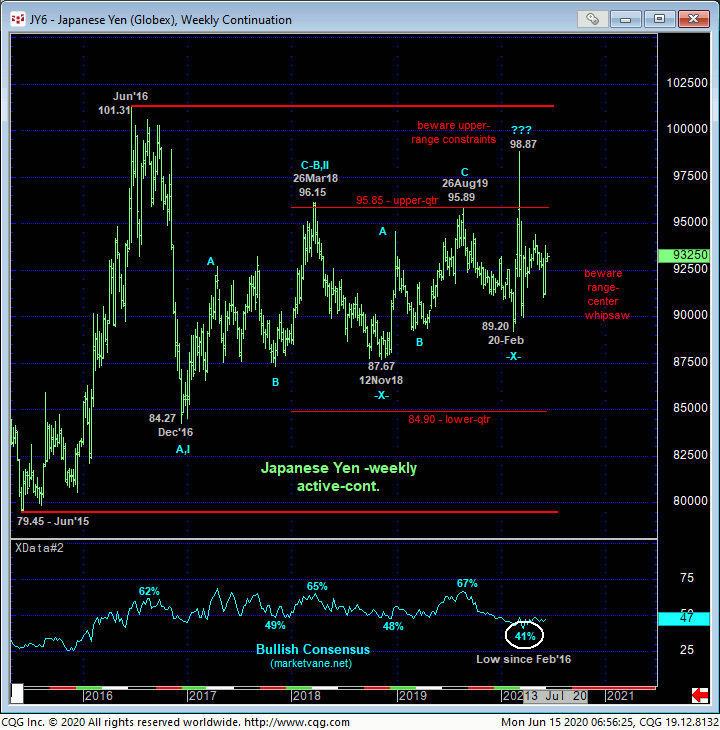
SEP EURO
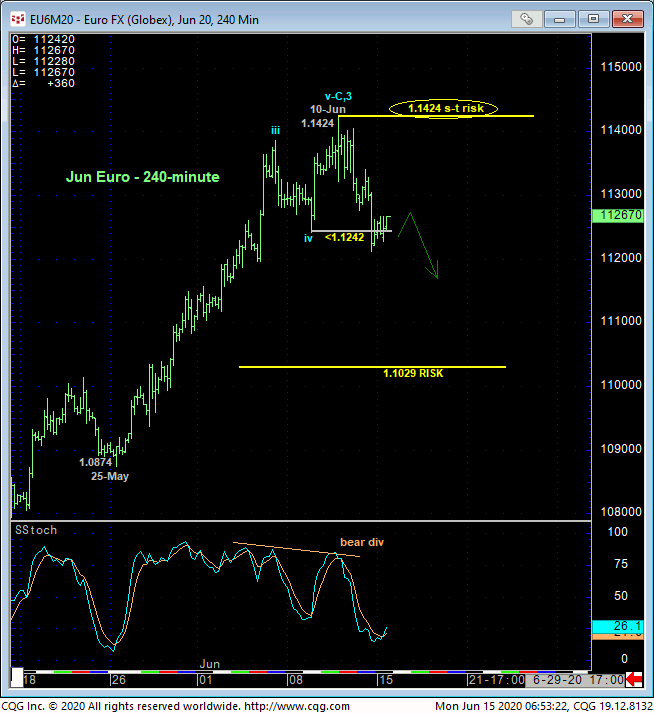
The market’s short-term momentum failure Fri below Tue’s 1.1266 corrective low and short-term risk parameter in the then-prompt Jun contract (above) discussed in Wed’s Technical Blog confirms a bearish divergence in momentum that breaks the past few weeks’ impressive uptrend. Basis the now-prompt Sep contract shown in the 240-min chart below, this mo failure has defined last week’s 1.1447 high as the end of the rally. Per such, we’ll be using this 1.1447 level as our new short-term risk parameter from which traders can base non-bullish decisions like long-covers and cautious bearish punts.
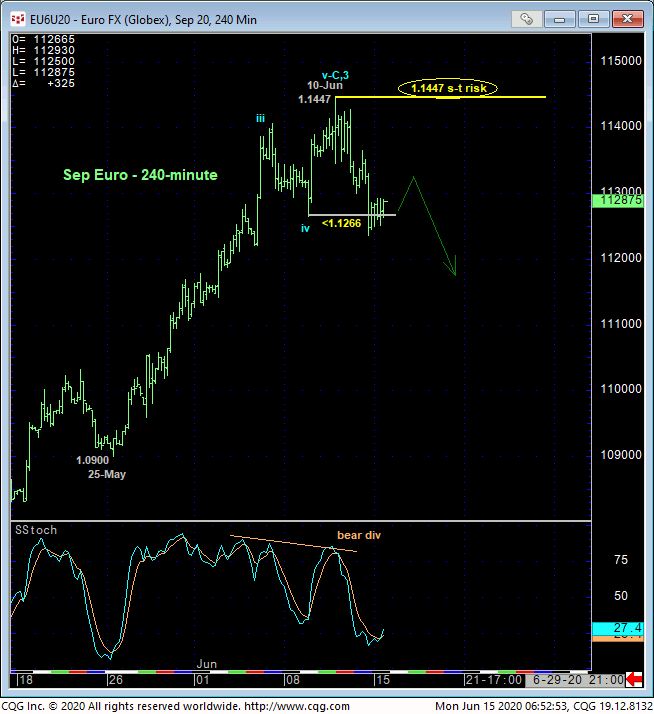
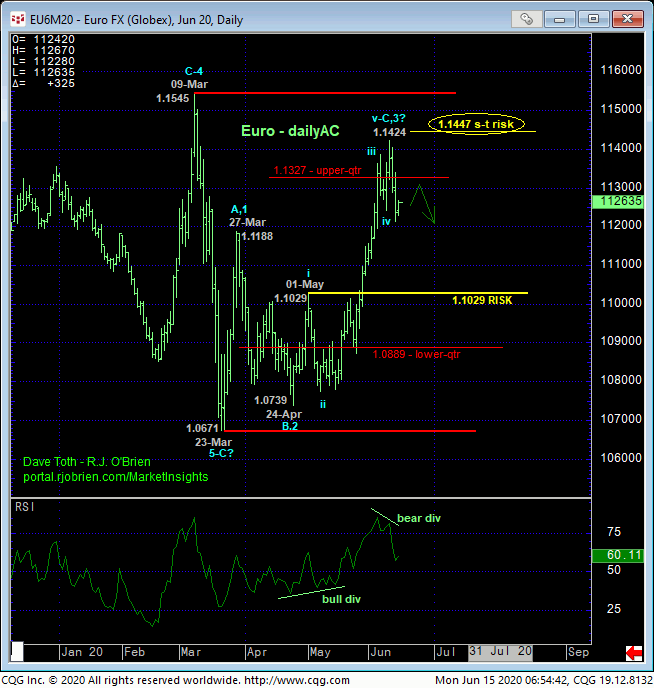
Taking a step back, the daily chart above shows May-Jun’s rally to be a very impressive, impulsive one that easily qualifies as a 3rd-Wave, suggesting this current setback may only be a (4th-Wave) correction ahead of a resumption of the bull. HOWEVER, the fact that this admittedly short-term momentum failure stems from the upper-quarter of a 1.15-to-1.07-range that has constrained this market for nearly a YEAR warns us to be alert for another patented intra-range relapse like we’ve seen in Dec/Feb, Mar and late-Mar/Apr. IF this setback is merely a 4th-Wave, then we know exactly the level the market’s now got to recoup to prove so: 1.1447.
From a “theoretical” Elliott Wave basis, this market would have to relapse below a suspected 1st-Wave high at 1.1029 from 01-May to negate the impulsive integrity of such a broader bullish count. But against the backdrop of the past year’s broader, lateral and volatile range, such a risk parameter is impractical, so longer-term traders are urged to exchange whipsaw risk (above 1.1447) for greater nominal (below 1.1029) and use that 1.1447 level as a risk parameter from which to pare or neutralize bullish exposure.
These issues considered, traders have been advised to move to a neutral/sideline position to circumvent the intra-range depths unknown of a correction or reversal lower. A recovery above 1.1447 is required to negate this specific call, reinstate the bull and expose potentially sharp gains thereafter. Until and unless such 1.1447+ strength is proven, we anticipate lateral-to-lower prices in the period ahead that could morph into a return to the middle-half bowels of this range around the 1.10-handle or lower.
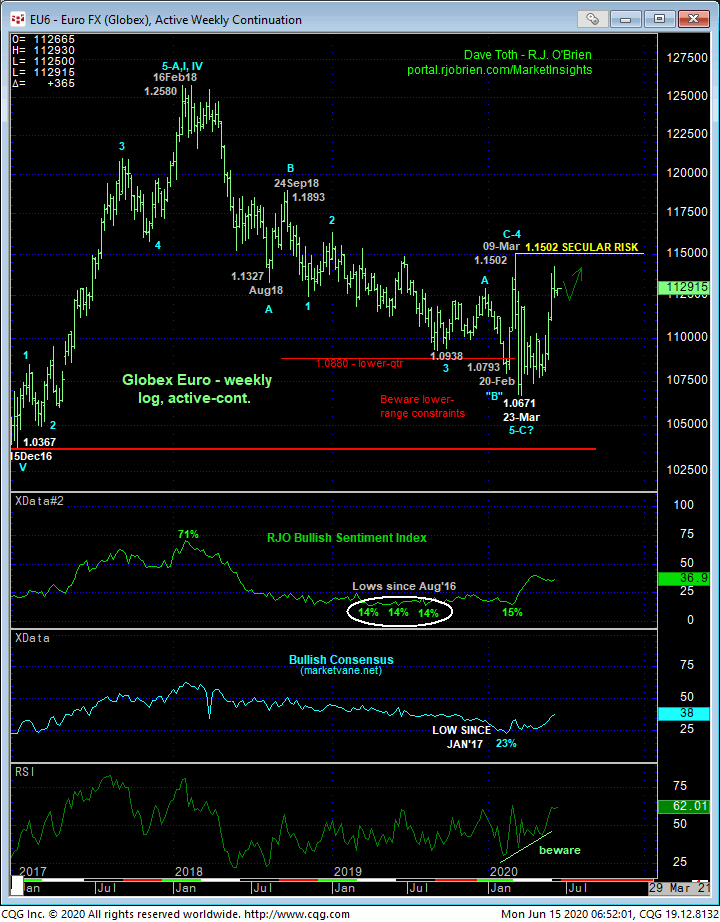
SEP BRITISH POUND
Similarly, the 240-min chart of the now-prompt Sep contract below shows Fri’s short-term momentum failure below 04-Jun’s 1.2501 corrective low and our short-term risk parameter that defines 10-Jun’s 1.2813 high as the end of the rally from 18-May’s 1.2079 larger-degree corrective low and new short-term risk parameter from which to base non-bullish decisions like long-covers and cautious bearish punts ahead of suspected lateral-to-lower prices in the period ahead.
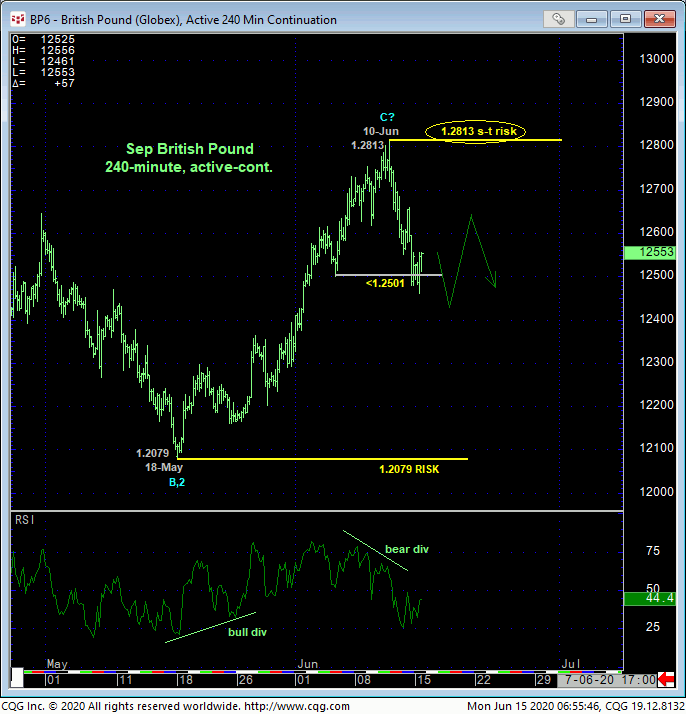
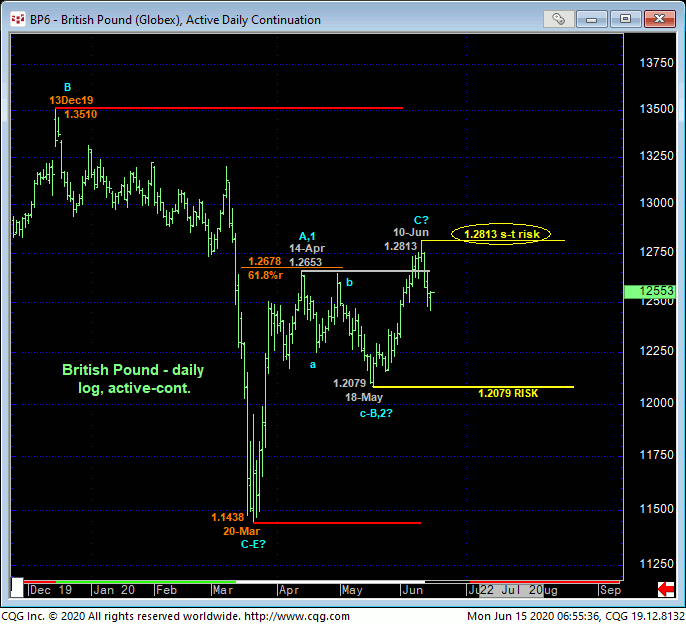
Unlike the euro, the daily (above) and weekly (below) chart of sterling show this market still in the middle-half bowels of the past nine months’ range where we approach the odds of aimless whipsaw risk as higher, warranting a more conservative approach to risk assumption that places an emphasis on identifying tighter but objective risk parameters like 1.2813. Commensurately larger-degree weakness below 18-May’s 1.2079 next larger-degree corrective low is required to break the broader developing uptrend from 20-Mar’s 1.1438 low, but against the backdrop of the broader, erratic 9-month range, making bearish decisions down there is impractical. Per such, we’re advising even long-term players to exchange whipsaw risk (above) 1.2813 for larger-degree nominal risk (below) 1.2079 and pare or neutralize bullish exposure as a result of Fri’s admittedly short-term mo failure.
These issues considered, traders have been advised to neutralize bullish exposure to circumvent the depths unknown of an intra-range correction or reversal lower. A recovery above 1.2813 is required to negate this call, resurrect the bull and expose potentially sharp gains thereafter. Another bearish divergence in short-term mo following a recovery attempt to 1.2650-area levels OB could price a favorable risk/reward punting opportunity from the bear side with protective buy-stops just above 1.2813.
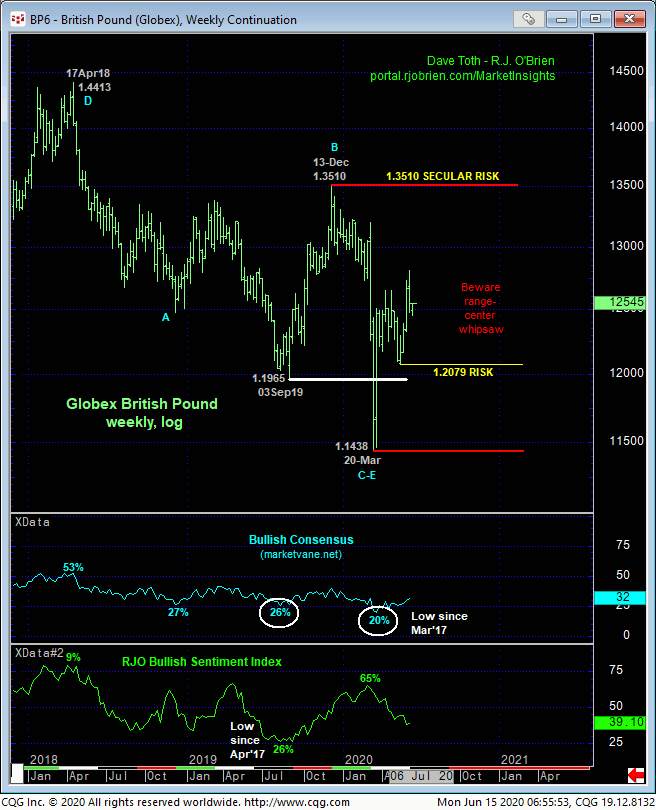
SEP JAPANESE YEN
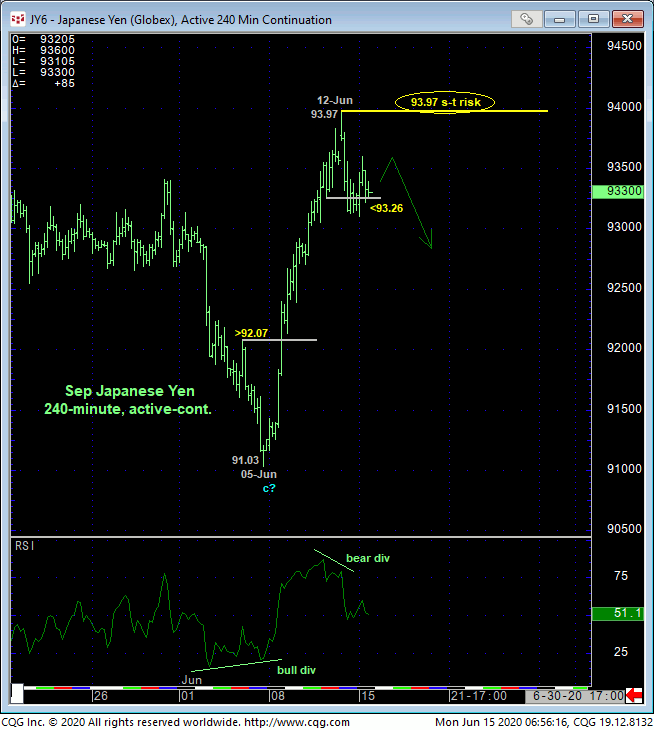
Fri’s short-term mo failure below 93.26 stemming from the the extreme upper recesses of the past 2-1/2-months’ lateral range likewise breaks early-Jun’s uptrend and exposes another intra-range relapse. Fri’s 93.97 high thus serves as our new short-term but key risk parameter from which non-bullish decisions like long-covers and bearish punts can be objectively based and managed.
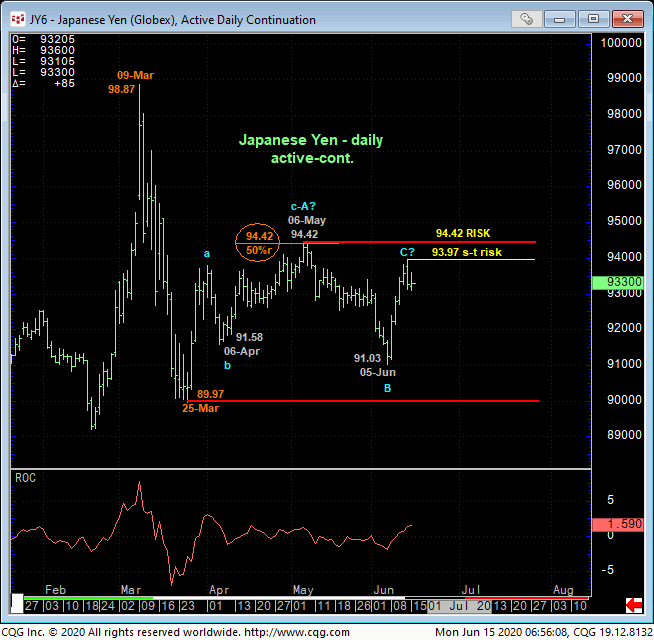
The fact that the past 2-1/2-month range is a subset of the massive FIVE YEAR lateral range shown in the weekly chart below contributes to a continued challenging environment where whipsaw risk and unsustained trends should be considered the norm rather than the exception, warranting a more conservative approach to risk assumption. These issues considered, traders are advised to move to a cautious bearish policy from the 93.50-area OB with a recovery above 93.97 negating this call and warranting its cover.
